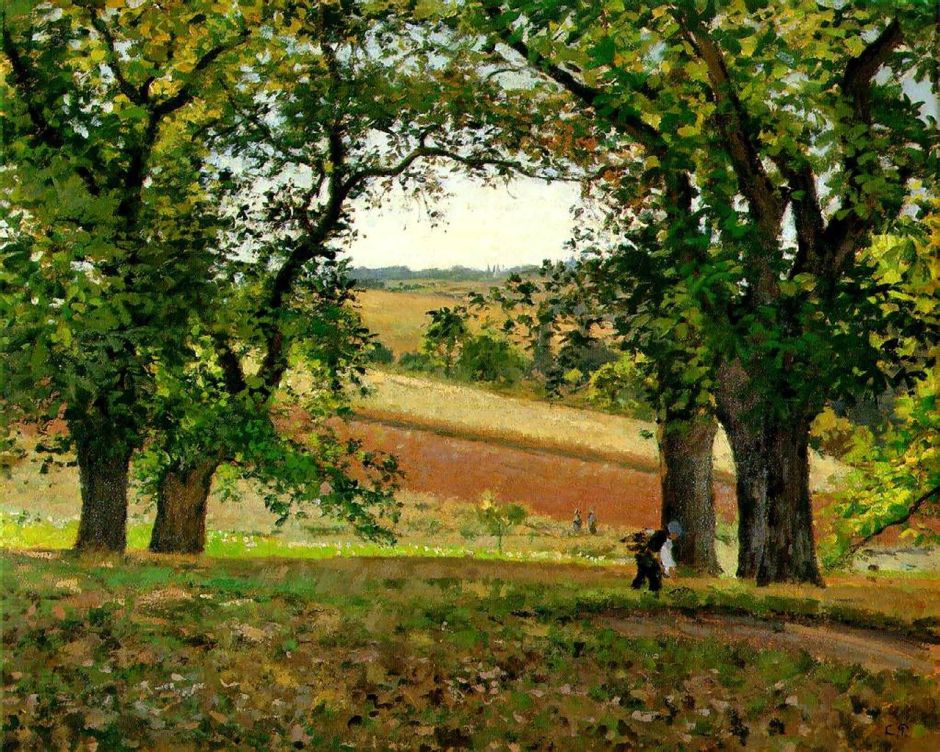Following the outbreak of the Franco-Prussian War, the Pissarros fled first to friends in Montfoucault, then in early December travelled on to England, where they settled in Norwood, at that time an outer suburb to the south of London. Camille and Julie, with their two children, stayed first in Lower Norwood, which is slightly closer to the city of London, before they joined Camille’s mother, brother and brother-in-law in Upper Norwood.
Although Pissarro is known to have painted only fourteen oils before returning to France, they mark an early peak in his art.

Fox Hill, Upper Norwood, Effect of Snow from December 1870 appears a sequel to his winter road scenes from Louveciennes, with its gentle staffage. Strangely it didn’t sell in Pissarro’s lifetime, but is now in the National Gallery in London, a few miles to the north.

For Pissarro, this superb view of The Avenue, Sydenham painted in 1871 was a landmark: it was the first painting which he sold to the dealer Paul Durand-Ruel, another refugee from the war whom he met in London. Durand-Ruel didn’t sell this painting, and it wasn’t until a sale at Christie’s in 1984 that it was purchased for a public collection, again that of the National Gallery in London.
Unusually, Pissarro painted a preparatory gouache of this view, which looks along what is now known as Lawrie Park Avenue towards Saint Bartholomew’s Church, which had been built in 1832.
Durand-Ruel was also important in securing both Pissarro and Monet admission to the International Exhibition of art in South Kensington, London, after their paintings had been rejected by the Royal Academy. Pissarro had two paintings exhibited there, and some favourable criticism, but little came as a result.

On 14 June 1871, Camille and Julie married in nearby Croydon. The artist’s present to his wife was this delicate View of Alleyn Park, West Dulwich which he had painted earlier that year. Taking Sydenham Hill as his vantage point, Pissarro here looks down over Alleyn Park towards the white chapel of West Norwood cemetery.

This part of what is now South London was becoming rapidly urbanised when Pissarro lived there. This had been accelerated by the opening of the Crystal Palace in 1854, and the expansion of the railways to encourage the more affluent to move out to these leafy suburbs and commute into the city each day. In 1870, a large college was opened to provide private education for the children of those richer families, and the following year Pissarro painted it in this view of Dulwich College, London.
With the Paris Commune crushed, and order being restored to France under the new Republic, the Pissarros returned to live a more settled life in Louveciennes again, after the shock of discovering that most of his 1500 or so paintings had been damaged or destroyed by occupying Prussian soldiers. There Pissarro lived close to Alfred Sisley, and the two often painted in company. Renoir’s mother also lived in the village, which enabled the three painters to meet quite frequently.
Among Pissarro’s favourite motifs in this post-war period were numerous views of the Route de Saint-Germain and other roads around Louveciennes, and the River Seine at Bougival.

Less well known are his watercolours, such as this view of Louveciennes, Route de Saint-Germain from 1871, which are reminiscent of the paintings of Johan Jongkind.

This is a wintry scene of The Post-House, the Route de Versailles, Louveciennes, Effect of Snow from 1872. This looks from the ‘Royal Gate’ of the Château de Marly towards the post-house, a landmark which features in several of Pissarro’s works from this period. This painting was bought that Spring by Durand-Ruel, who sold it a year later to Jean-Baptiste Faure, the opera singer and Pissarro’s first collector.

At this stage of his career, there’s no evidence that Pissarro set out to paint formal series in the way that he did later. The compilation above shows some examples drawn from his ‘road’ paintings during the period prior to and immediately after the Franco-Prussian War.

Pissarro painted this woodland view of an Avenue in the Parc de Marly in the autumn of 1871. It looks towards the village of Marly-le-Roi from the Port du Phare, inside the grounds of the Château de Marly. His skilful use of staffage draws the eye towards the far end of the avenue. The artist seems to have sold this painting quite quickly to an unknown buyer, from whom Durand-Ruel bought it in early 1873.

Pissarro must have taken delight in the weird forms of the trees in this Chestnut Grove at Louveciennes, which he painted in 1872. In the far distance is the massive warm cream stone of Marly Aqueduct.
Although the Pissarros were able to live on the money generated by Camille’s painting, they must have got by in relative poverty. However, in 1872, he sold four stretched canvas overdoor panels depicting the seasons to the banker Achille Arosa for 100 Francs each. Pissarro tried to buy them back when they came up for auction in 1891, but despite appealling to Vincent van Gogh’s brother Theo, they were sold for just over a thousand Francs to the Bernheim-Jeune Gallery, and have remained in private collections since.
In April 1872, the Pissarros moved from Louveciennes to Pontoise, where they rented a house and Camille established his studio.
In 1873, Pissarro was one of the prime movers of the French Impressionists. It was he who first suggested that they should set up their own alternative to the Salon, and he was one of the those who established their official Société Anonyme collective, and wrote their charter. Pissarro was in effect the father of the Impressionists, both in age and role. In the summer, he started renting a studio in Montmartre.

Pissarro’s output while he lived in Louveciennes and Pontoise was prodigious and of very high quality. One painting which stands out, though, is Hoar Frost at Ennery from 1873, which was exhibited at the First Impressionist Exhibition the following year, bought that autumn by Faure, and now graces the Musée d’Orsay in Paris.
Some of the critics of the day praised it, comparing it to some of Millet’s best paintings, but the influential Castagnary was acid in his comments, and another described its frost on deeply-ploughed furrows as “palette scrapings placed uniformly on a dirty canvas.”
One interesting observation about this work is Pissarro’s overt use of colour in its shadows, a controversial issue at the time. The rhythmic cast shadows of trees are here dark brown where they fall on the ploughed area, and blue-green further back where they fall on frost-covered grass.

Chestnut Trees at Osny from about 1873 was another of Pissarro’s paintings exhibited at the First Impressionist Exhibition, which also gained some praise, in this case from the critic writing for L’Artiste. It was exhibited in 1883 at the Durand-Ruel Gallery, where it was much better appreciated, but remained in the artist’s own collection until his death.
Pissarro had painted a few family portraits and even some still lifes over these years, and in about 1874 painted his famous heart-felt portrait of Paul Cézanne, who had been a close friend since they first met in 1861.

This image of Pissarro’s painting of the Farm at Montfoucault from 1874 is valuable for its lightly raking light, which reveals the texture of the paint surface. It also demonstrates how Pissarro could use lower chroma when the lighting conditions dictated. This painting was made while the Pissarros spent the winter with their friends in Montfoucault, and exhibited at the Second Impressionist Exhibition. Like so many of his paintings it remained unsold when the artist died in 1903.
Tomorrow I’ll look at the landscape paintings of Alfred Sisley over the same period.
References
Brettell RR (1990) Pissarro and Pontoise, Yale UP and Guild. ISBN 978 0 300 04336 5.
Pissarro J (1993) Pissarro, Pavilion Books and Harry N Abrams. ISBN 1 85793 124 6.
Pissarro J and Snollaerts CD-R (2005) Pissarro. Critical Catalogue of Paintings, 3 vols, Wildenstein Institute and Skira. ISBN 88 7624 525 1.
Rothkopf K ed (2006) Pissarro. Creating the Impressionist Landscape, Philip Wilson, London. ISBN 0 85667 630 6.

